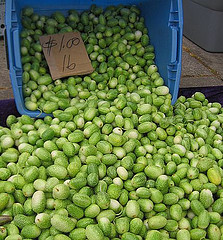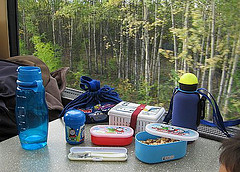How to cut your food bills
 With food prices going up and the economy looking bleak, a lot of us are looking for ways to tighten our belts and save money. Food budgets add up, and there are more creative ways of cutting costs than eating macaroni and cheese all the time.
With food prices going up and the economy looking bleak, a lot of us are looking for ways to tighten our belts and save money. Food budgets add up, and there are more creative ways of cutting costs than eating macaroni and cheese all the time.
Packing your own lunch instead of buying lunch in a restaurant or cafeteria is an obvious money-saver, but there’s more that you can do to shop smart, reduce food waste, and conserve resources in the kitchen. Now, I’ll be the first to admit that I don’t follow *all* of the tips below, so just pick and choose the ones that work for your lifestyle. Read on to save money: 1) at the store, 2) at home, and 3) when traveling or dining out.
How do you cut food costs at home? Share your own tips in comments!
SAVE MONEY AT THE STORE
1. Choose your stores wisely
- Balance a store’s savings with how far out of your way you’d have to go (factor in the cost of gas or public transportation).
- Don’t just default to your nearest supermarket for all of your food shopping; actually compare prices on items you buy regularly to see which is actually cheaper. Look at the unit price (how much per ounce or per serving) to make true comparisons.
- Local farms, farmer’s markets or CSAs often sell fruits and vegetables for cheaper than supermarket prices (plus you’re supporting local farmers). Find a U.S. farmer’s market near you with this tool or these listings.
- If you buy a lot of food for one cuisine, it’s often cheaper at markets specializing in that cuisine (Asian, Mexican, Arab, Latin American, Mediterranean, etc.).
- Outlets or close-out stores like Big Lots and Dollar General often sell miscellaneous pantry items at deep discounts. Take advantage and stock up on your favorites, but be sure to look at expiration dates and make sure cans aren’t dented.
- Stores? Who needs stores? Grow your own herbs or produce in a garden, either outside, on a rooftop, patio, or inside. I personally have a black thumb, but if you have a green thumb you can cut your food costs and enjoy the freshest produce.
2.  Shop smart
Shop smart
- Buy fruits and vegetables in season. Track what’s in season where you live, and keep this in mind when you’re shopping. Out-of-season tomatoes and berries will cost a lot compared to how much they are in season. If you’re handy, you can buy a lot of produce cheaply in season and preserve it through freezing or canning.
- Buy generic store brands if there’s no dramatic quality difference. You’re often paying for the more expensive brand’s advertising for similar quality food..
- Look for clearance and sale items, not only on the shelves but also in separate sale areas of the store.
3. Use coupons
- In addition to weekly circulars that you find in newspapers and stuffed in your mailbox, try some of the online coupon sites where you can print out coupons to bring with you, such as GetLocalDeals, HotCoupons.com, ValPak, SmartSource, Cool Savings, and EverSave. Watch out if you have to register — use a separate e-mail account so you don’t drown in spam.
- Are there days when the coupons can be redeemed at your local store for more than face value? Double coupon days?
- Keeping a coupon wallet
, organizer or even an envelope in your car or purse to help keep your coupons organized and at hand. It doesn’t help to have clipped a coupon if you can’t find it when you’re shopping!
4. Buy in bulk
- Repackage fresh items in smaller quantities for freezing so that you can take out just as much as you need for easy cooking.
SAVE MONEY AT HOME
5. Use a food inventory system
This will help you stay on top of perishable foods that need using up before they go bad, remind you of what’s buried in your freezer and cabinets, and keep you from overbuying food that you already have.
- An inventory system can be as simple as a chalkboard or dry-erase whiteboard listing perishables, food magnets that help you track freezer or refrigerator contents, or as complicated as a computer spreadsheet with a full inventory of your food.
7. Plan out your menus
- Whether it’s a week or a month ahead of time, planning your meals in advance helps save money by helping you shop bargains, use up leftovers, and reduce food waste. You won’t overbuy if you have a shopping list in hand with only what you need for that week’s menu. You can also draw up the week’s menu after checking up on your local market’s upcoming sales and coupons, planning the meals based on what’s cheap that week.
I’m notoriously bad at creating menus, but meal planning websites like Meals Matter or tools like the Laptop Lunch planning worksheet can help.
- Go easy on the meat. Making the occasional vegetarian meal or using just a bit of meat in a stir-fry instead of making a roast will cut down on food costs.
8. Recycle things in the home for kitchen use
There’s no limit to how creative you can get if you’re of a mind to. Some examples I found in Shufu no Tomo’s money-saving book “Setsuyaku no Urawaza Shittoku Memo” include:
- Drain fried foods on newspaper instead of a new paper towel.
- Use trimmed milk cartons as compost containers, drawer or freezer organizers, etc.
- Save condiment packets from take-out or fast food meals to use in packed lunches.
- Save food containers like margarine tubs, glass jars and lidded condiment cups, wash, and reuse.
- Line compost containers with old newspaper instead of expensive biodegradable trash bags.
- Cut off the top third of a plastic water bottle, invert it, and use it as a funnel.
- Wash and reuse plastic wrap and plastic bags. Okay, this is a little extreme for me, but theoretically it makes sense and reduces plastic waste.
9. Reduce energy consumption in the kitchen
Okay, so you might feel like you’re channeling the spirit of people who lived through the Depression, but some of their thrifty habits can come in handy. Some examples I found in Shufu no Tomo’s money-saving book “Setsuyaku no Urawaza Shittoku Memo” include:
Cook in bulk and freeze the excess in smaller portions. For example, make a big batch of rice and freeze in individually wrapped portions. Take out only as much frozen rice as you need at a single meal, and microwave or re-steam only. This uses less electricity than using the Keep Warm function on a rice cooker for hours, or making a new batch of rice for small portions.
- Try multi-cooking, where you cook different foods together in the same container. For example, when grilling, frying, boiling, broiling, or steaming in a rice cooker.
If you boil more water than you need, pour the excess into a thermos for use later (either for tea or washing dishes in hot water).
- Don’t fully fill the sink with hot water to wash just a few dishes: fill a smaller container or wash dishes directly in a pot that needs washing anyway. Use hot water leftover from boiling food to wash dishes in.
- If you have a dishwasher, turn off the heated dry cycle and let dishes air dry.
- Run your dishwasher during off-peak hours if you pay variable rates for utilities.
- Check to see how energy-efficient your dishwasher is; some recent models have a “rinse” cycle that uses less water than you would rinsing each plate individually in the sink.
- When boiling water, adjust the flame so that it’s not wider than the base of the pan you’re using. One way around this is to boil water in a saute pan or frying pan instead of a small saucepan, or use an electric kettle (see my post on Kettle races: Electric vs. stovetop).
- Similar to a low-energy slow cooker is the insulated thermal cooker,
where you bring food to a boil and close it all up in an insulated pot. Residual heat slowly cooks the food inside without using additional energy.
11. Bring your restaurant leftovers home
- You might think that that extra meatball or two isn’t worth packing up, but think in bento terms. It might not be a full serving, but it could be a perfect nibble tucked into a bento lunch with other items or incorporated into another dish in a Leftover Remake. You paid for it, so get your money’s worth! Find out how to pack a bento lunch and fill gaps.
- If you’re on the road, try to bring along nesting bento boxes or a collapsible sandwich case in your bag so that you can pack a bento lunch out of large restaurant portions for the next day. Store it in your hotel’s minibar refrigerator. See my post on travel bentos.
12.  Pack a lunch to eat on the airplane/train instead of buying their in-flight meals or food from airport restaurants. See my post on how to pack a bento lunch for the plane.
Pack a lunch to eat on the airplane/train instead of buying their in-flight meals or food from airport restaurants. See my post on how to pack a bento lunch for the plane.
- Bring an empty reusable drink bottle or canteen. When you’ve passed through security, fill it from a water fountain and maybe add a powdered drink add-in for flavor.
- Speaking of bottled water, you can save money by drinking tap water from a reusable water bottle instead of buying disposable bottled waters. If your tap water isn’t up to snuff, consider buying a water filter or filtering system.





Recent Comments
FAQ
Richard Malakuskie | The Nerdie Birdie | Shaking up the Lunch Routine: Popcorn with Toppings - Popcorn Blog | Justin Wright | The White Plate Kitchen |
Oshibori: We don’t need no stinking wet wipes!Daniel |
Homemade gnocchi box lunches (22)Lisa |
Guide to choosing the right size bento box (82)Julie |
Confessions of an ostrichBernice |
Top Tips (4)miamidish.net | Cheap Seat Eats |
How to make Spam Musubi (69)Scratching Ramen |
School auction bentos with stuffed mushrooms (8)Marci |
Speed Bento: leftover storage and portion guidelinesAdverbios de tiempo |
Fried Shrimp Bentos: Simple vs. Fancy (43)Mimi |
Fruit cup jello jigglers in everyday containers (42)Madison Moms Blog |
Limited edition “Bento Sensei” shirts for J-POP (2)runeanimer |